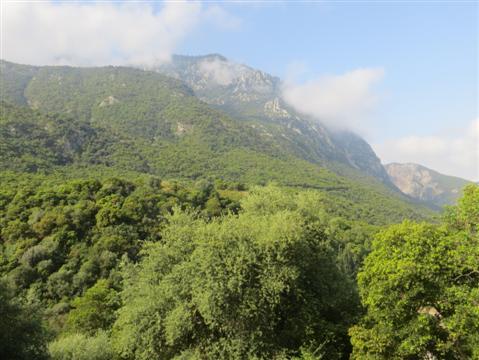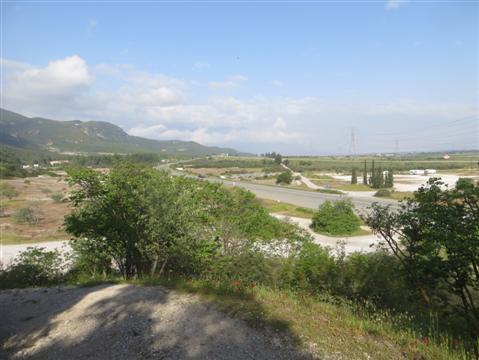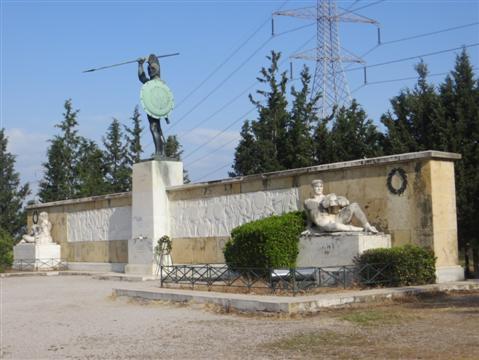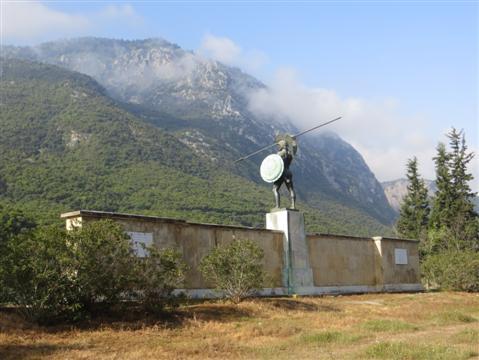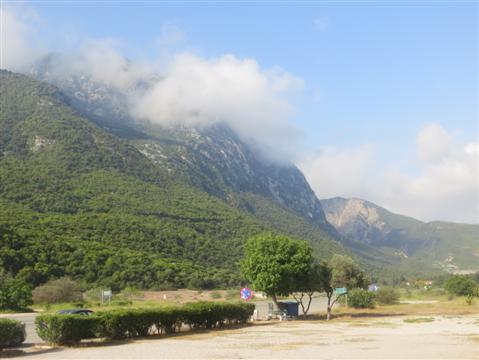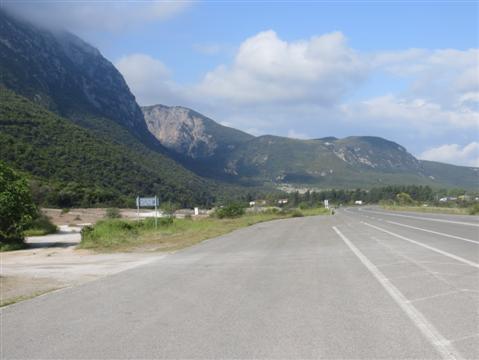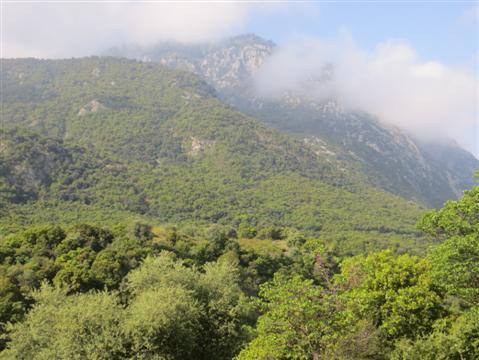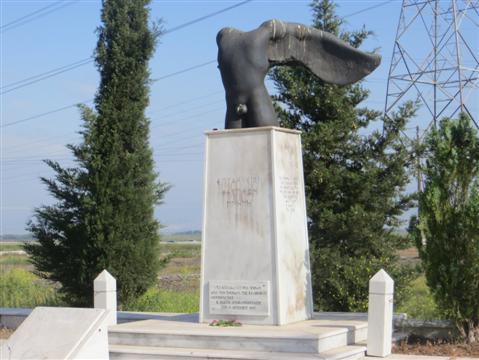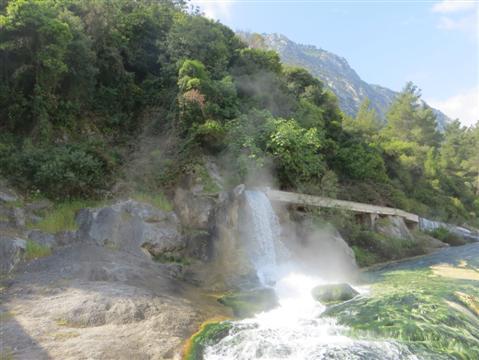If Leonidas, the storied king of Sparta, and his 300 heroic warriors were to return today to Thermopylae, arguably the most famous last stand in history, they would not recognize the site where treachery thwarted their valiant attempt to keep King Xerxes and the invading Persians out of southern Greece 2,500 years ago.
They'd know the steep forested slopes and the soaring, cloud-wreathed craggy peaks of Thermopylae, yes, and the steaming thermal sulfur pools that gave the site its name, meaning Hot Gates. But where's the sea that made this pass the impregnable defense against Xerxes and his vast host of serried troops?
The sea once hugged this pass so closely that a few thousand Greeks could hold off 1.7 million Persians, if the ancient historian Herodotus is to be believed, in the 300-foot wide defile where numerical superiority was useless.
But thanks to silting over the millennia, it has now retreated up to five miles to the east, leaving a wide flat plain -- with two roads and a tangle of power lines -- which would have been ideal for the Persian king to move his millions.
Actually, those huge numbers are doubtless wildly over the top. Modern historians estimate the Persians at between 70,000 to 140,000, while total Greek forces under Leonidas numbered 7,000. But that in no way detracts from the Greeks' superb strategy.
Today a giant bronze statue of Leonidas stands on a marble plinth, helmetted, shield by his side in his left hand, spear raised above his right shoulder, gaze fixed determinedly on the soaring mountains, and butt turned fully to the plain that didn't exist then and would most certainly have put the kibosh on his plans.
He looks much younger than the 60 years he was at his death and he's totally naked. He was certainly dressed way back in August 480 B.C., so I don't know what they're up to here.
Leonidas gazes towards the mountains that made the pass
There are three 'gates' in the defile of Thermopylae, and Leonidas and his warriors made their stand at the second where the mountain ramparts made a particularly suitable bottleneck.
On the first day of battle, Leonidas staged a tactical retreat, luring the Persian multitudes deeper into the defile. Then he charged and cut the enemy to pieces, the volley of Persian arrows easily deflected by the stout Greek shields, the shorter Persian spears no match for the longer Greek lances.
Xerxes then mounted a second assault, sending in the 10,000 'immortals,' his own elite personal bodyguard. The Greeks soon gave the lie to their name, cutting them to pieces as well.
On the second day Xerxes sent Leonidas a message. 'Give up your arms,' said His Persian Majesty.
'Come and get them,' said His Spartan Majesty in reply.
So Xerxes sent in his best infantry -- to be cut to pieces, too. Now we know why Einstein defined insanity as doing the same thing over and over again and expecting a different result.
On the evening of the second day Xerxes' luck changed. A certain Ephialtes, a Greek from Trachis, came to him and offered to show him, for a hefty reward, a mountain path that bypassed Thermopylae.
This prototype of the modern Quisling thus gained an immortality denied Xerxes' own immortals and his name entered the Greek language not only for traitor, just as his World War II spiritual heir in far off Norway did in English, but also as a word for nightmare.
Now Leonidas had foreseen the possibility that the Persians would learn of the mountain path and he stationed a detachment of Phocians there. They, however, thought the Persians had come for them and retreated to a nearby hill to make a stand. The Persians showered them with arrows and quickly moved on.
On the third day of the battle Leonidas and the Greeks were about to be cut off from the rear. Learning from a courier that the Phocians had not held the path and realizing it was useless to sacrifice the lives of thousands of Greek warriors, Leonidas ordered them to retreat back to southern Greece to fight another day, though some say the Greeks left anyway without his order.
Leonidas stayed with his 300 Spartans, and a further 700 Thespians and 400 Thebans who refused to leave. Of course not a man survived, thus endowing Thermopylae with its heroic aura of courage and impregnable patriotism as the most famous last stand in history. Americans of course would dispute this, pointing to the siege of the Alamo instead -- so for them this would be Greece's Alamo.
On the low hillock of Kolonos across from nude Leonidas, a stone memorial was laid in ancient times with an inscription by the poet Simonides: 'You, stranger, go to the Lacedaemonians (Spartans) and let them know that we lie here faithful to their laws.' The stone has not survived but a replacement was put there in 1955. Leonidas himself stands above an inscription of his famous challenge 'Come and get them.'
A few dozen yards to his right, a headless naked torso of winged victory stands in tribute to the Thespians who did indeed show they could act -- in the sense of taking action. The word thespian for actor does not in fact come from these good citizens of Thespiae, but from some gent called Thespis, who in 534 B.C. became the first person to act by playing a person in a play instead of speaking for himself.
Despite its lowly height Kolonos was morally loftier even than Mt. Everest, according to the 1st century philosopher Apollonios Tyaneus. Well, he didn't know of Everest, of course, but visiting Kolonos he called it the highest mountain in the world because 'the noble self-sacrifice put up a monument which has its base on Earth and reaches the stars.'
Thermopylae was to become the site of another battle 2,421 years later, when in April 1941, Australian and New Zealand troops faced off against the invading Germans. But because of the topographical changes, this was never meant to be the blocking strategy of Leonidas, merely a delaying tactic.
Following the Greeks' heroic defeat the Persians poured south and entered and burned much of Athens, which had been evacuated. But they were defeated at sea by the Athenians at the battle of Salamis, and that sounded the death knell of their Greek adventure.
A small museum to the left of nude Leonidas gives an excellent account of the battle, including a 3D film of each of the three days.
A little up the road, near the first gate, the boiling waterfall that gave Thermopylae its name still pours out of the rocky mountainside into a pool, steam and the smell of sulfur still filling the air.
The hot springs that gave Thermopylae its name
By the same author: Bussing The Amazon: On The Road With The Accidental Journalist, available on Kindle, with free excerpts at http://www.amazon.com/dp/B00KNCGD9M and in print version on Amazon at http://www.amazon.com/dp/1499681984:
